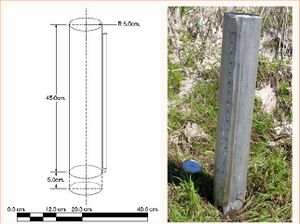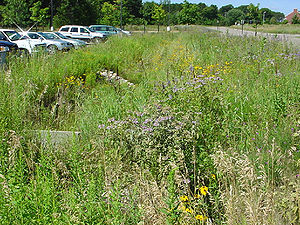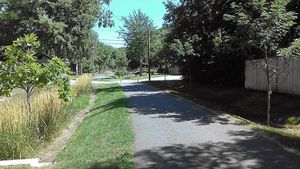
Operation and maintenance (O&M) of swales Revision as of 17:19, 28 January 2023 by Mtrojan (talk | contribs) (→Design phase O&M considerations)
This page provides guidance for operation and maintenance (O&M) of swales. This includes dry swales, wet swales, bioswales, and high gradient step pools.
Supplemental information can be found on the page called Operation and maintenance of swales - supplemental information. Supplemental information includes the following.
- Infiltration rate service life before clogging
- Nitrogen reduction
- Phosphorus reduction
- Heavy metals retention
- Erosion protection
- Sediment monitoring, removal, and disposal
- Seeding, planting, and landscaping maintenance
- Snow and salt considerations
- Maintenance agreements
- References
Contents
Overview of typical O&M issues
A grass or dry swale is a general term for filtration or infiltration conveyance practice, but there are a wide variety of designs depending on the site requirements. The key functions of swales are to convey water with reduced peak velocities and to perform water quality treatment with filtration and infiltration. Swales have the benefit of providing ecological function in areas dominated by development and impervious surface. These practices are ideal for urban settings, which creates an opportunity for humans to impact their function through vandalism, littering, and vehicular traffic.
These practices, like other green stormwater infrastructure, require regular maintenance to ensure proper and long-lasting ecosystem and stormwater function. If properly maintained, swales can operate effectively for 20-50 years, depending on the design type. Vegetated dry swales may perform properly for up to 50 years (Malvern Borough, 2013). The most frequently cited O&M concerns for swales include the following.
- Standing water in the swale after a 48 hour timeline to infiltrate runoff
- Loss of volume storage due to accumulated sediment
- Clogged soil media
- Clogged inlet and outlet structures, or underdrains
- Growth and proliferation of weeds or other non- native species that threaten the long-term effectiveness of the swale
The sections below describe best practices to prevent or minimize these common problems.
Design phase O&M considerations
Swales, like other infiltration practices in urban areas, may be subject to higher public visibility, greater trash loads, pedestrian traffic, vandalism, and vehicular loads. Designers should design these practices in ways that prevent or minimize O&M issues. Examples include the following.
- Designing easy-access points for maintenance personnel and equipment
- Limiting the contributing drainage area and sizing the practice in accordance to its contributing drainage area
- Adding pretreatment and trash racks to reduce sediment and debris loads.
- Providing a vegetation design plan, emphasizing the following considerations
- Utilizing native plantings that enhance pollinator and wildlife habitat, improve infiltration and erosion protection
- Evapotranspiration, reduce urban heat island effect, provide optimized carbon sequestration, and provide climate adaptation. Native plantings typically require less maintenance and replacement than non-native plantings because they are adapted to the local climate (see Plants for Stormwater Design).
- Site-specific plantings that take into account sun exposure, shade, proximity to traffic corners (visibility issues), interior vs exterior plantings, salt-tolerant plants, etc. The selection of plantings suitable to their immediate surroundings will minimize long-term care and replacement frequency.
- Providing educational signage for swales in residential areas to increase public awareness
Designers should consult and include any local requirements regarding green infrastructure. O&M considerations often depend on whether the practice is located on public land, private land, or in the public right of way. For example, plantings in the public right of way that conflict with any traffic safety considerations could require increased O&M, such as pruning or complete removal. Swales are particularly subject to traffic considerations and regulations, given their frequent placement in public right-of-way.
The designer should also provide a site-specific O&M plan that includes the following.
- Construction inspection schedule and checklists
- Post-construction routine maintenance schedule and checklists
- Operating instructions for the practice (if applicable)
For more information on design criteria for dry swale (grass swales).
Construction phase O&M considerations

Proper construction methods and sequencing play a significant role in reducing O&M problems. Some key items during the construction phase include the following.
- Before construction begins
- Install erosion control prior to excavation of swale
- Hold a pre-construction meeting to review the construction plans and the sequencing of construction
- Designate a stormwater supervisor to make sure someone is responsible for erosion and sediment control.
- During construction
- Construct any pretreatment devices first to trap sediments.
- Ensure heavy equipment does not enter the footprint of the practice to avoid compaction of the growth medium
- Ensure the correct plant species are being installed by having a detailed list of species and quantities. These should be spelled out in the plan set both in the Details and Specifications and on actual drawings. A copy should be kept on one’s person at all times during construction.
- Inspect the practice during construction to ensure that the swale is built in accordance with the approved design and standards and specifications. Use a detailed inspection checklists that include sign-offs by qualified individuals at critical stages of construction, to ensure that the contractor’s interpretation of the plan is acceptable to the professional designer.
- Conduct soil infiltration tests to ensure proper soil compaction
- After construction
- Verify that the swale was built in accordance with the approved design and standards and specifications
- Verify that the practice properly conveys, filters, and/or infiltrates runoff. Ensure that no standing water remains within the swale 48 hours after precipitation.
- Verify that pretreatment functions properly
- Use a detailed inspection checklists that include sign-offs by qualified individuals at the completion of construction, to ensure that the contractor’s interpretation of the plan is acceptable to the professional designer. An example construction phase inspection checklist is provided here.
- Review and discuss the plant warranty/establishment period with the plant provider to understand the conditions under which failing plants will be replaced. Divert stormwater away from BMP during establishment phase as necessary for the selected vegetation.
- Determine if stormwater should be kept offline from the practice until the seedlings are established.
- The design/construction team should provide the O&M team with the following information to be included in the O&M plan.
- The plant warranty.
- The as-built plans of the practice.
- A list of conditions that might cause failure of the practice if not properly maintained.
Post-construction phase O&M
Effective short and long-term performance of grass swales requires a dedicated and routine maintenance plan with clear guidelines, expectations, and schedules. Proper maintenance will not only increase the effectiveness of the swale at treating stormwater runoff, but will create a viable green space supporting ecological function. A maintenance plan clarifying maintenance responsibilities should be required for all practices.
Some important post-construction considerations are provided below along with recommended maintenance standards.
- A site-specific O&M plan should be prepared by the designer prior to completing construction of the grass swale. This plan should provide any operating procedures related to the practices. The plan should also provide clear maintenance expectations, activities, and schedules, including minimum maintenance frequencies expected. Include photos if possible. Be clear about who is responsible for the maintenance and the type of expertise that will be needed for distinct O&M activities. The O&M plan should include an anticipated budget for O&M activities. The O&M plan should also include an example O&M inspection checklist and an example maintenance report. Example O&M plans and inspection checklists are provided further down below.
- A legally binding and enforceable maintenance agreement should be executed between the practice owner and the local review authority. Link here for example maintenance agreements.
- Inspection and maintenance activities are distinct and can be done as separate activities or together. Inspection will typically assess the practice for any O&M issues, whereas maintenance will address the O&M issues identified by the inspection. A dedicated inspection effort on a large number of BMPs can help prioritize maintenance activities.
- Maintenance activities should be careful not to cause compaction.
- Ponded water that does not infiltrate within 48 hours of a storm is an indicator the swale is not functioning properly. If ponded water is observed outside of a routine O&M schedule it should be addressed immediately.
- Best management practice (BMP) areas generally should not be used as dedicated snow storage areas. Snow storage within swales should be avoided when possible, such as in parking lots. Snow storage can cause compaction and increase sedimentation within the swale over time, and so snow storage on swales designed for infiltration should be specifically avoided. Link here for more information.
Overview and schedule of general maintenance activities for swales
Link to this table
| Activity | Frequency | Time Period | Level of Effort | O&M Benefit1 |
|---|---|---|---|---|
| Check that there is no ponding | 48 hours after event | All year long | 1 hour | 1 |
| Inspect entire BMP after rainfall | After any event greater than 0.5” | All year long (or during area’s rain season) | 2-4 hours | 1 |
| Correct earthwork if inlet scouring or unwanted flow paths develop | As needed | All year long | >4 hours | 1 |
| Spot reseed bare patches and eroding areas | As needed | First growing season | 2-4 hours | 3,4,5 |
| Supplemental watering during drier periods, particularly if keeping stormwater offline until plant seedlings are established. | As needed | Dry periods | 1-2 hours | 3,4,5 |
| Remove any stormwater diversion or barriers once seedlings are established. | Once | When plants are sufficiently established | 1-2 hours | 1,2,3,4,5 |
| Inspect and remove invasive plants and weeds during plant community establishment | Monthly | First growing season | 1-2 hours | 5,6 |
| Mowing (dry swales) side slopes and/or grass filter strip to maintain 4-12” of height | Seasonally | As needed (do not interrupt any vegetative establishment) | 2-4 hours | 1 |
| Activity | Frequency | Time Period | Level of Effort | O&M Benefit1 |
| Check that there is no ponding | 48 hours after event | All year long | 1 hour | 1 |
| Inspect inlet/outlet structures for structural damage and clogging. | Annually | All year long | 1-2 hours | 1 |
| Correct earthwork if inlet scouring or unwanted flow paths develop | As needed | All year long | >4 hours | 1 |
| Mowing (dry swales) side slopes and/or grass filter to maintain 4-12” of height | Seasonally | All year long | 2-4 hours | 1 |
| Inspect for trash and debris | Seasonally | All year long | 2-4 hours | 1,5 |
| Check for evidence of clogging in the pre-treatment device and/or in the main treatment area. | Biannually | In spring and fall | 1-2 hours | 1 |
| Inspect and remove excess sediment in the pre-treatment device and/or in the main treatment area. | Annually | In spring (post- snowmelt) and fall | 4 hours if removal is needed | 1 |
| Inspect plant composition and health and replace as needed (maintain >95% vegetative cover) | Biannually | In fall or spring | 4 hours if plant replacement is needed | 4,5 |
| Prune and weed to maintain appearance and proper vegetative cover | As needed | Growing season | 1-2 hours | 4,5,6, |
| Activity | Frequency | Time Period | Level of Effort per Visit | O&M Benefit1 |
| After long term operation of the practice, some occasional and infrequent maintenance activities might be required, such as bigger repairs, soil regeneration, or redesign of key elements of the practice. | As needed | As needed | Could be significant depending on the activity | 1,2,3,4,5,6 |
1Key to Maintenance Benefits:
| ||||
Common problems and how to troubleshoot them for swales
Link to this table
| Symptom | Possible Causes | Solution |
|---|---|---|
| Standing water within the swale for more than 48 hours | Soil media may be clogged with accumulated sediment or the outlet structures may be clogged with trash or de |
|
| Vegetation is not able to establish | Plant selection is inappropriate for the site | Consult with a landscaper or horticulturist. Check that plants are suited to the local conditions. Make sure BMP is protected from snow storage or salt application. |
Maintenance costs
Maintenance costs will vary on a number of factors, including but not limited to the following.
- Size of the practice and its contributing drainage area
- Type of plantings used
- Site visit frequency
- Level of maintenance needed
- Local weather conditions
- Staffing needs (number of staff, external vs. internal staff, etc)
- Travel time between sites
- Efficiencies of scale (single GI vs. a cluster of GI)
- Equipment needed
Maintenance costs will vary depending on the size of the practice, its contributing drainage area, type of plantings, and whether it is part of a larger green infrastructure effort. Preventative maintenance is key to minimizing major costs associated with repairs. A general rule of thumb to estimate annual maintenance costs is 5%-7% of the installation costs for swales (CWP, 2017). In 2014 dollars, the annual cost of maintenance is approximately $0.06-$0.12 per square foot of practice, which adjusts to $0.07-$0.14 in 2021 dollars, as estimated in the National Stormwater Calculator (Clary, 2017). Maintenance may be higher the first few years, while plants are being established.
Maintenance costs should account for the number of hours of labor, the cost for different types of labor expertise required, and any equipment needed to successfully complete the maintenance activities.
Useful resources
Additional detailed O&M information
More detailed information regarding specific maintenance activities are provided here. Topics discussed include
- sustainable service life for infiltration and bioretention BMPs;
- erosion protection and sediment monitoring, removal, and disposal;
- seeding, planting, and landscaping maintenance;
- snow and salt considerations;
- maintenance agreements; and
- aditional References.
Case studies
- Grass Swales: Gauging Their Ability to Remove Pollutants From Highway Stormwater Runoff - Wisconsin DOT, 2007.
Maintenance training documents and videos
- Training and certification programs on designing, installing, and maintaining stormwater BMPs.
Example O&M plans, checklists, reports, and maintenance agreements for swales
Link to this table
| Document | Link |
|---|---|
| Operation & Maintenance Plan | |
| Construction phase inspection checklist |
|
| O&M inspection checklist |
|
| O&M example report | |
| Maintenance Agreements |
References
- Malvern Borough. 2013. Vegetated Swales.
- Clary, J., Piza, H. 2017. Cost of Maintaining Green Infrastructure. American Society of Civil Engineers (ASCE), Reston, VA.
Related pages
- Terminology for swales (grass channels)
- Overview for dry swale (grass swale)
- Types of infiltration
- Types of filtration
- Design criteria for dry swale (grass swale)
- Construction specifications for dry swale (grass swale)
- Operation and maintenance of dry swale (grass swale)
- Assessing the performance of dry swale (grass swale)
- Calculating credits for dry swale (grass swale)
- Cost considerations for dry swale (grass swale)
- Case studies for dry swale (grass swale)
- Plants for swales
- Check dams for stormwater swales
- External resources for dry swale (grass swale)
- References for dry swale (grass swale)
- Requirements, recommendations and information for using dry swale (grass swale) without an underdrain in the MIDS calculator
- Requirements, recommendations and information for using dry swale (grass swale) with an underdrain in the MIDS calculator
- Requirements, recommendations and information for using swale side slope as a BMP in the MIDS calculator
- Dry swale (grass swale) and interesting websites
Green Infrastructure
- Green Stormwater Infrastructure (GSI) and sustainable stormwater management
- Operation and maintenance of green infrastructure practices
- Operation and maintenance of bioretention and other stormwater infiltration practices
- Operation and maintenance of bioretention and other stormwater infiltration practices - supplemental information
- Operation and maintenance (O&M) of tree trenches and tree boxes
- Operation and maintenance of tree trenches and tree boxes - supplemental information
- Operation and maintenance (O&M) of green roofs
- Operation and maintenance of green roofs - supplemental information
- Operation and maintenance (O&M) of swales
- Operation and maintenance of swales - supplemental information
- Operation and maintenance (O&M) of filter strips
- Operation and maintenance of filter strips - supplemental information
- Operation and maintenance (O&M) of stormwater and rainwater harvest and use/reuse practices
- Operation and maintenance (O&M) of stormwater and rainwater harvest and use/reuse practices - supplemental information
- Operation and maintenance (O&M) of stormwater treatment wetland practices
- Operation and maintenance (O&M) of permeable pavement
- Operation and maintenance (O&M) of permeable pavement - supplemental information
This page was last edited on 28 January 2023, at 17:19.



